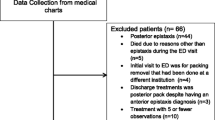Abstract
Epistaxis is a very common ENT event. Apart from the effectiveness of the different treatment options, the discomfort and the financial burden are of great importance. It has been the aim of this study to obtain data regarding the discomfort/pain of the epistaxis treatments and to calculate the financial burden. During the period between April 2010 and July 2011 epistaxis patients at our hospital had the opportunity to rate the discomfort/pain they experienced during their treatment on a 0–10 VAS scale. The costs of epistaxis treatments were calculated in an extended cohort. 84 VAS scores in 61 patients were acquired and the costs of treatment were calculated in 96 patients. The lowest VAS scores were found in chemical and electric coagulation with 1.5 and 2.0, respectively, followed by surgery (3.0), Rapid Rhino® packing (6.0) and balloon pack (7.5). The costs of treatments depended on whether the treatment was in an out- or inpatient setting. Surgery was not significantly more expensive than packing methods in the inpatient setting. Anterior epistaxis could be managed by local coagulation with an acceptable impact/cost ratio. At our institution, surgery was the most cost effective and the least troublesome procedure in posterior bleedings, preceded by Rapid Rhino® packing if required.




Similar content being viewed by others
References
Viehweg TL, Roberson JB, Hudson JW (2006) Epistaxis: diagnosis and treatment. J Oral Maxillofac Surg 64(3):511–518. doi:S0278-2391(05)01815-X
Small M, Murray JA, Maran AG (1982) A study of patients with epistaxis requiring admission to hospital. Health Bull (Edinb) 40(1):20–29
Toner JG, Walby AP (1990) Comparison of electro and chemical cautery in the treatment of anterior epistaxis. J Laryngol Otol 104(8):617–618
Badran K, Malik TH, Belloso A, Timms MS (2005) Randomized controlled trial comparing Merocel and Rapid Rhino packing in the management of anterior epistaxis. Clin Otolaryngol 30(4):333–337. doi:COA1019
Moumoulidis I, Draper MR, Patel H, Jani P, Price T (2006) A prospective randomised controlled trial comparing Merocel and Rapid Rhino nasal tampons in the treatment of epistaxis. Eur Arch Otorhinolaryngol 263(8):719–722. doi:10.1007/s00405-006-0047-5
Chheda N, Katz AE, Gynizio L, Singer AJ (2009) The pain of nasal tampon removal after nasal surgery: a randomized control trial. Otolaryngol Head Neck Surg 140(2):215–217. doi:S0194-5998(08)01407-1
Singer AJ, Blanda M, Cronin K, LoGiudice-Khwaja M, Gulla J, Bradshaw J, Katz A (2005) Comparison of nasal tampons for the treatment of epistaxis in the emergency department: a randomized controlled trial. Ann Emerg Med 45(2):134–139. doi:S0196064404014957
Hirsh AT, Atchison JW, Berger JJ, Waxenberg LB, Lafayette-Lucey A, Bulcourf BB, Robinson ME (2005) Patient satisfaction with treatment for chronic pain: predictors and relationship to compliance. Clin J Pain 21(4):302–310. doi:00002508-200507000-00004
Woolhandler S, Himmelstein DU (1997) Costs of care and administration at for-profit and other hospitals in the United States. N Engl J Med 336(11):769–774. doi:10.1056/NEJM199703133361106
Altman SH, Shactman D (1997) Should we worry about hospitals’ high administrative costs? N Engl J Med 336(11):798–799. doi:10.1056/NEJM199703133361111
Himmelstein DU, Thorne D, Warren E, Woolhandler S (2009) Medical bankruptcy in the United States, 2007: results of a national study. Am J Med 122(8):741–746. doi:S0002-9343(09)00404-5
Soyka MB, Nikolaou G, Rufibach K, Holzmann D (2011) On the effectiveness of treatment options in epistaxis: an analysis of 678 interventions. Rhinology 49(4):474–478. doi:10.4193/Rhin
Soyka MB, Rufibach K, Huber A, Holzmann D (2010) Is severe epistaxis associated with acetylsalicylic acid intake? Laryngoscope 120(1):200–207. doi:10.1002/lary.20695
Van Wyk FC, Massey S, Worley G, Brady S (2007) Do all epistaxis patients with a nasal pack need admission? A retrospective study of 116 patients managed in accident and emergency according to a peer reviewed protocol. J Laryngol Otol 121(3):222–227. doi:10.1017/S0022215106003148
Klotz DA, Winkle MR, Richmon J, Hengerer AS (2002) Surgical management of posterior epistaxis: a changing paradigm. Laryngoscope 112(9):1577–1582. doi:10.1097/00005537-200209000-00008
Kumar S, Shetty A, Rockey J, Nilssen E (2003) Contemporary surgical treatment of epistaxis. What is the evidence for sphenopalatine artery ligation? Clin Otolaryngol Allied Sci 28(4):360–363. doi:724
Wang L, Vogel DH (1981) Posterior epistaxis: comparison of treatment. Otolaryngol Head Neck Surg 89(6):1001–1006
Goddard JC, Reiter ER (2005) Inpatient management of epistaxis: outcomes and cost. Otolaryngol Head Neck Surg 132(5):707–712. doi:S0194599805001518
Schaitkin B, Strauss M, Houck JR (1987) Epistaxis: medical versus surgical therapy: a comparison of efficacy, complications, and economic considerations. Laryngoscope 97(12):1392–1396. doi:10.1288/00005537-198712000-00003
Moshaver A, Harris JR, Liu R, Diamond C, Seikaly H (2004) Early operative intervention versus conventional treatment in epistaxis: randomized prospective trial. J Otolaryngol 33(3):185–188
Rejas Ugena E, Trinidad Ruiz G, Alvarez Dominguez J, Carrasco Claver F, Pino Rivero V, Blasco Huelva A (2006) Utility of the surgical treatment for severe epistaxis by endoscopic approach of sphenopalatine and ethmoidal arteries. Acta Otorrinolaringol Esp 57(5):228–234
Christensen NP, Smith DS, Barnwell SL, Wax MK (2005) Arterial embolization in the management of posterior epistaxis. Otolaryngol Head Neck Surg 133(5):748–753. doi:S0194-5998(05)01752-3
Miller TR, Stevens ES, Orlandi RR (2005) Economic analysis of the treatment of posterior epistaxis. Am J Rhinol 19(1):79–82
Conflict of interest
All authors state that there are no conflicts of interest to disclose. There are no financial disclosures.
Author information
Authors and Affiliations
Corresponding author
Rights and permissions
About this article
Cite this article
Nikolaou, G., Holzmann, D. & Soyka, M.B. Discomfort and costs in epistaxis treatment. Eur Arch Otorhinolaryngol 270, 2239–2244 (2013). https://doi.org/10.1007/s00405-012-2339-2
Received:
Accepted:
Published:
Issue Date:
DOI: https://doi.org/10.1007/s00405-012-2339-2




